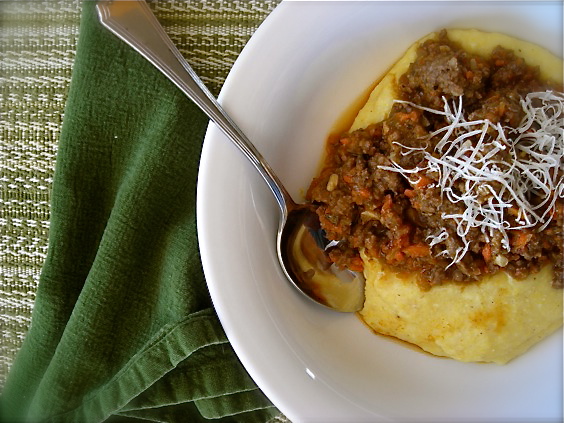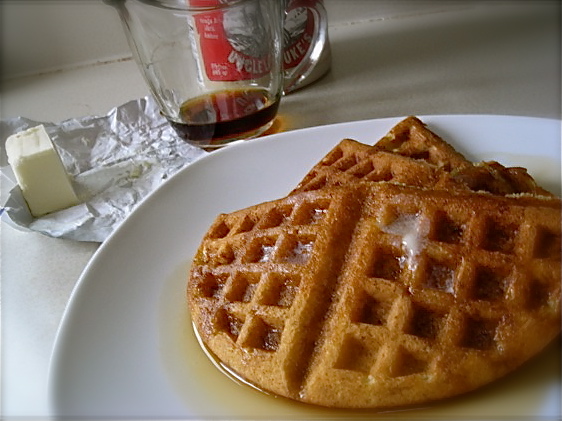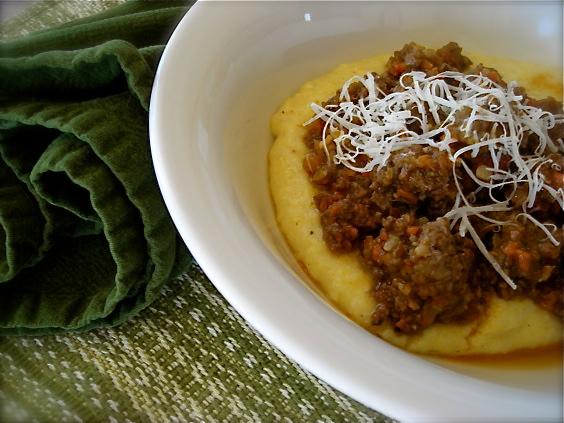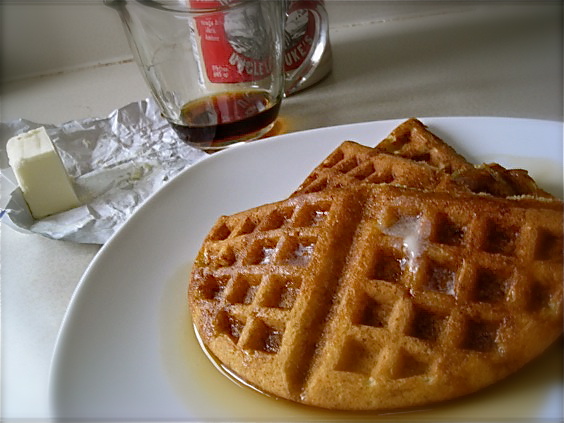November 21st, 2011
| 2 Comments »
This dish, if I wanted something really meaty and amazing, would be the first thing I turn to in order to quench that carnivorous desire.

I made this back in late winter, in that transitional time between seasons where it isn’t always cold but it’s not exactly warm either, and it was perfect to fill our bellies with a heated depth to fend off the last of winter. The flavor is out-of-this-world good; rich and deep and lush on the tongue, and after the initial prep period, this is a no-brainer as it sits on the stove and gently simmers to a thick and delicious dish. Your house will smell amazing, and once it’s done, it can be spooned over pasta, grains or egg noodles, or like this version, atop a creamy dish of soft polenta.
With the onset of snow in Minnesota, this is a welcome choice for a cozy dinner.
Hearty Ragù with Soft Polenta
1# each ground beef and ground pork (i used 93/7 ground beef)
1/2 t. salt
1/4 t. fresh ground black pepper
2 small onions, peeled and cut to large pieces
2 carrots, peeled and cut to large pieces
2 stalks celery, with leaves, cut to large pieces
4 cloves garlic, peeled
2 T. olive oil
1 t. crushed dried rosemary leaves
1 14.5-oz can Muir Glen Organic Meridian Ruby tomatoes (or use equivalent of other kind)
1 c. dry red wine
1 quart good chicken stock
1/2 t. ground nutmeg
In a 4-qt dutch oven, brown the meat with salt and pepper over medium heat until no longer pink. Drain fat using a colander over a large bowl. Discard fat, set meat aside.
In large food processor, place onions, carrots, celery and garlic and process until finely chopped. In same dutch oven, add olive oil, vegetables and rosemary, cooking for about 15 minutes or until vegetables start to brown.
Add tomatoes and meat to pan, stir to combine. Cook approximately 15 minutes, until tomatoes darken slightly. Add red wine, increase heat to medium-high and cook until liquid reduces by about half. Add chicken stock, reduce heat to low and simmer, stirring occasionally, for 3-4 hours. Stir in nutmeg in final minutes of cook time.
KATE’S NOTES: For extra richness in this dish, I added about a half cup of heavy cream with the chicken stock. I think it made an exceptional addition. When you add the stock, the mixture will be very loose, like a soup. It will reduce as it simmers though. I did not cover the pan as it cooked, but I doubt it will make much difference, although it may take longer for the liquid to reduce if it’s covered.
From Cascina Spinasse, Seattle Washington, and Chef Jason Stratton
from the Muir Glen Tomato Vine Dining Tour recipe booklet
Creamy Soft Polenta
1/2 c. stone ground corn meal
1 c. fat free milk
1 c. water
1 t. butter
Salt and pepper as needed
In a heavy medium saucepan, bring milk, water and butter to a boil then add cornmeal in a thin stream, whisking constantly. Once cornmeal is added, whisk for several minutes to insure smooth consistency. Bring to a simmer, reduce heat to low and cover the pan, leaving lid ajar to release steam. Simmer polenta for about 10 minutes, stirring often to keep it from scorching, then add 2-3 tablespoons of water. Stir to combine, replace cover (leaving it ajar) and simmer for 10-15 minutes more, stirring regularly, scraping the bottom to prevent scorching. Add about 2-3 more tablespoons of water at this point, stir to combine and cook for about 5 more minutes, stirring regularly. Taste for texture; it should be smooth, and not at all grainy. If any graininess remains, add a few more tablespoons of water and cook until smooth. Serve immediately. Makes about 2 servings
KATE’S NOTES: Be aware that Polenta, as it cooks, bubbles like molten lava, and it can be dangerous if not kept partially covered. Keep the heat low to prevent the bubbles from exploding violently. And when you stir the polenta as it cooks, make sure you are scraping the pan bottom thoroughly. I used a flat edge wooden spatula for this. A heat resistant rubber spatula would also be a good option.
November 5th, 2011
| 2 Comments »
It’s November again. And this morning when I arose, in the dark still silence, to the hum of the furnace and an noisy, eager cat face, the air smelled definitively of the impending winter. Never mind that it might reach near 60 today, or that the sun burns bright in that kind of blue sky that hurts your eyes, the wind that touched my face when I let out our early riser told me ‘You know, I could snow at any minute.’

We’re pretty fortunate that our Fall has been both spectacular and snowless. The only month without recorded snowfall in Minnesota is July, and with the frost that came so early in September, I felt certain that a drifting white mass would come sooner or later. I’ve been happy to be so, so wrong.
These Cornmeal Waffles are a favorite cold weather breakfast. First crafted and enjoyed on a crackling, numbingly cold day in January of 2010, they’ve gained a permanent foothold in my breakfast rotation, the waffle recipe I turn to time and again. With their crisp edges, and the sharp tang of buttermilk contrasting with the deep, rich maple syrup, it’s a dance of flavors to awaken you and set you upright, not to mention bolstering you against cold and wind.
The inevitable Winter is just around the corner. Shore up your weekends with foods that bring warmth to your home and fuel for the internal furnace. These waffles freeze beautifully. I always make a double, or even a triple batch so that we have lots of extras on hand.
Do you have a preference for Waffles or Pancakes??
Buttermilk Cornmeal Waffles
1 cup sifted all-purpose flour (sift before measuring)
1 cup yellow cornmeal, preferably stoneground
2 teaspoons baking powder
1 teaspoon baking soda
1/4 teaspoon salt
3 large eggs
2 cups well-shaken buttermilk
6 tablespoons vegetable oil plus additional oil for brushing waffle iron
Into a large bowl sift together flour, cornmeal, baking powder, baking soda, and salt. Repeat sifting 2 more times.
In another large bowl whisk together eggs, buttermilk, and oil. Add flour mixture all at once and whisk just until combined.
Preheat a waffle iron and preheat oven to 200 °F.
Brush waffle iron lightly with additional oil. Spoon batter into waffle iron, using 1/4 cup batter for each 4-inch-square standard waffle and spreading batter evenly, and cook according to manufacturer’s instructions. Transfer waffle to a baking sheet and keep warm, uncovered, in middle of oven. Make more waffles with remaining batter in same manner, brushing waffle iron with more oil before adding each batch.
Serve waffles with syrup.
(from Kristin at The Kitchen Sink Recipes, slightly adapted from Gourmet magazine)
What’s on YOUR plate this month??

February 20th, 2011
| 6 Comments »
There’s still enough wintertime for this dish…….. especially with yet another major storm bearing down on Minnesota.

There’s still enough of winter for a slow stove-top meal, one that fills your kitchen with a heady fragrance, a simmer that beckons one and all from the cold and wind to a wide shallow bowl of tender meat and vegetables, rich with rosemary and basil. Winter still has us in it’s grasp despite the longer hours of the day, our luck changing as we see traces of the sun through our dinner hour, a few more precious hours of light in the afternoon when school is done. Pick a slow weekend day if you can, to enjoy the hours with a bubbling pot on the stove, as sun moves to twilight. Or place it all in a crock pot before you head out the door for work, then come home to a sensational smell, and a hearty rustic dinner. This is the quintessential Winter meal; it’s warm and rich and soothing and amazingly good. It’s rustic and simple and easy to prepare. And it makes good on the promise of chasing the cold away.
Recently I attended a dinner that featured organic Muir Glen tomatoes, and as we gathered our coats to leave, smiling from content tummies, chatting heartily with each other, the sponsor of the meal handed everyone a gift bag that held a small cookbook of tomato recipes, plus a sampling of some of Muir Glen’s finest canned tomatoes. The dinner, highlighting Muir Glen’s specialty selection of canned tomatoes, the Meridian Ruby variety, was held at five locations with their resident chefs around the country, the local establishment being Corner Table in Minneapolis. The small booklet that came with the gift bag had recipes that made my eyes dance with delight, and the very first one listed was the traditional Ragù recipe from Cascina Spinasse in Seattle. The restaurant serves traditional Northern Italian fare, which includes this hearty meat-based sauce; slowly simmered pork and beef, with minced carrot, celery, onion and garlic to round out the flavors. Add wine, Muir Glen’s fresh and flavorful Meridian Ruby tomatoes and let it bubble contentedly on the stove for a few hours. Who needs a plane ticket?

Ok, I agree…. a plane ticket to Italy would be fine, yes. BUT…. this dish is far cheaper.
As it cooked, simmered and blended on the stove, filling my kitchen with it’s rich scent, I felt like I’d be selling such a beauty short by serving it over boring old pasta. I know it would taste fine, sure…. but its decadence and hearty flavor made me wish for a creamy soft polenta to top it with. After all, if this Ragù was traditional Northern Italian fare, then a bowl of creamy polenta would be a natural base. And there I kind of balked. It’s a good thing the pot went in the refrigerator overnight so I could mull on how best to tackle this need.
Because you see, several years ago I went through a phase where I repeatedly tried polenta, in as many forms as I could manage. I tried it with white corn meal, in true Southern Grits fashion; I tried it in solid form, broiling or searing small cakes of it to golden perfection before topping it with whatever I was experimenting with at the time. I tried recipe after recipe of soft polenta and every single time I ended up disappointed, or worse, really turned off. I decided that maybe I just didn’t like polenta, but then I’d try it in a restaurant and be bowled over with how delicious it was. And I loved cornbread, corn muffins, hush puppies and corn fritters, so what was it about polenta that I couldn’t manage? I’m pretty sure it was the cooking method, but by the time I figured it out, I was so over making it at home. And I haven’t attempted it since.
This time, I was determined, and after consulting with my friend Shaina, I armed myself with some of her knowledge and feedback and headed into the kitchen. Thirty minutes later, a pot of superbly creamy and flavorful polenta was waiting for the rich and hearty Ragù. The first bite made me swoon, eyes rolling in delight. It was, through my hands and a little attention, the most delicious food I’ve ever made at home, and it was happily making it’s way to my mouth. I cook a lot. And I cook really well, but this was the first time I think anything I’d made could stand up to the food served in a good restaurant.
But then, I suppose when you have with a recipe that comes from one of Food and Wine’s Best New Chefs of 2010, that’s probably a good start.
Spinasse Ragù
1# each ground beef and ground pork (i used 93/7 ground beef)
1/2 t. salt
1/4 t. fresh ground black pepper
2 small onions, peeled and cut to large pieces
2 carrots, peeled and cut to large pieces
2 stalks celery, with leaves, cut to large pieces
4 cloves garlic, peeled
2 T. olive oil
1 t. crushed dried rosemary leaves
1 14.5-oz can Muir Glen Organic Meridian Ruby tomatoes (or use equivalent of other kind)
1 c. dry red wine
1 quart good chicken stock
1/2 t. ground nutmeg
In a 4-qt dutch oven, brown the meat with salt and pepper over medium heat until no longer pink. Drain fat using a colander over a large bowl. Discard fat, set meat aside.
In large food processor, place onions, carrots, celery and garlic and process until finely chopped. In same dutch oven, add olive oil, vegetables and rosemary, cooking for about 15 minutes or until vegetables start to brown.
Add tomatoes and meat to pan, stir to combine. Cook approximately 15 minutes, until tomatoes darken slightly. Add red wine, increase heat to medium-high and cook until liquid reduces by about half. Add chicken stock, reduce heat to low and simmer, stirring occasionally, for 3-4 hours. Stir in nutmeg in final minutes of cook time.
KATE’S NOTES: For extra richness in this dish, I added about a half cup of heavy cream with the chicken stock. I think it made an exceptional addition. When you add the stock, the mixture will be very loose, like a soup. It will reduce as it simmers though. I did not cover the pan as it cooked, but I doubt it will make much difference, although it may take longer for the liquid to reduce if it’s covered.
From Cascina Spinasse, Seattle Washington, and Chef Jason Stratton
from the Muir Glen Tomato Vine Dining Tour recipe booklet
Creamy Soft Polenta
1/2 c. stone ground corn meal
1 c. fat free milk
1 c. water
1 t. butter
Salt and pepper as needed
In a heavy medium saucepan, bring milk, water and butter to a boil then add cornmeal in a thin stream, whisking constantly. Once cornmeal is added, whisk for several minutes to insure smooth consistency. Bring to a simmer, reduce heat to low and cover the pan, leaving lid ajar to release steam. Simmer polenta for about 10 minutes, stirring often to keep it from scorching, then add 2-3 tablespoons of water. Stir to combine, replace cover (leaving it ajar) and simmer for 10-15 minutes more, stirring regularly, scraping the bottom to prevent scorching. Add about 2-3 more tablespoons of water at this point, stir to combine and cook for about 5 more minutes, stirring regularly. Taste for texture; it should be smooth, and not at all grainy. If any graininess remains, add a few more tablespoons of water and cook until smooth. Serve immediately. Makes about 2 servings
KATE’S NOTES: Be aware that Polenta, as it cooks, bubbles like molten lava, and it can be dangerous if not kept partially covered. Keep the heat low to prevent the bubbles from exploding violently. And when you stir the polenta as it cooks, make sure you are scraping the pan bottom thoroughly. I used a flat edge wooden spatula for this. A heat resistant rubber spatula would also be a good option.
DISCLAIMER:
I attended the dinner at Corner Table as a guest of Muir Glen and did not pay for my meal. The promotional products were
free of charge as well. I was not paid to endorse or even mention Muir Glen Meridian Ruby tomatoes, Chef Stratton’s restaurant, his recipe or any other information found here. The opinions in this post are strictly my own.
January 27th, 2010
| 25 Comments »
Winter weekends sure can be a mixed blessing. You’ve got an entire day spread out in front of you with endless possibilities; time on your hands and hours to make just the way you want, and yet, if you’re like those of us in Minnesota, you often wake on those long days to crackling cold air and sunshine thats full of promise but delivers nothing in warmth.
Those are the days that just require waffles.

There’s something about a crisp and aromatic waffle that deems it a culinary perfection for a chilly winter morning. A morning that you know needs to lead to a productive day. A morning where the coffee pot seems to be endlessly working, where your pajamas are often more desirable than a pair of blue jeans, mornings such as one that finds you casually sipping your brew, and noticing that the bright sunshine has highlighted your neglect of the vacuum cleaner, the dustmop and a Swiffer cloth or two.
I’m sure others can relate, right?
I grew up with Sunday morning waffles. It was eagerly anticipated to come down the stairs to the pungent scent of the percolator on the stove as it bubbled away, competing with the creaky old waffle iron, hissing emphatically, cranking out perfect rectangles of golden hued delectable treats. I do love pancakes, especially ones that stray off the beaten track of breakfast food; pancakes with shredded apples and yogurt in them, bananas and pecans in a whole wheat pancake, chocolate chip flecked ovals cooked to soft perfection and then topped with summer cherry sauce. Pancakes even spread with peanut butter and eaten out of hand. Oh, do we know about pancakes in this house, yes we do. But waffles, why there is really no other means needed to enjoy them other than good butter and syrup, because the waffle, in all it’s dented glory is the perfect palate to top with a few slices of cold butter and then drizzle warm maple syrup over to run through tunnels, cubes and edges to dress them in sweet buttery delight. Those edges crunch, the syrup absorbs and the bites come together in the mouth, a marriage to linger over, knife and fork in hand, coffee to the side. I’ll eat pancakes for dinner, and often we do, but waffles are strictly breakfast, and best on the weekends when their sturdy personality buoys you up for the long day ahead.
And who wouldn’t love the crunchy and wholesome addition of some cornmeal to the waffle?

I’ve made cornmeal studded pancakes before, and really, they’re pretty good and all, but there’s something about the added crunch of cornmeal on batter placed in the waffle iron that just sort of gets me right there. I don’t know how to describe it any more than that. And when I came across the recipe for these crunchy beauties on Kristin’s lovely blog, somehow I knew I would adore them like a treasured memory so I put together a double batch. People, I made waffles for hours, it seems. Hours. Did I care? Oh no, not at all. You see, after I made the first one and dressed it appropriately, I consumed it with gusto. My tummy, loving the introduction of it, politely asked for another. And I complied. The batter seemed endless, but I stockpiled waffles for the next few days and two packs to go into the freezer. We are happily away in waffle ecstasy. Don’t bother to look for us, ok? We’ll be fine, really and I will come back when they’re gone and do it all over again.
Oh yeah, and after I ate that delicious breakfast, it spurred me on to clean my house from top to bottom and boy, did it look nice in the dazzling but cold winter sunshine then. All thanks to a perfect little cornmeal waffle.
Buttermilk Cornmeal Waffles
(from Kristin at The Kitchen Sink Recipes, slightly adapted from Gourmet magazine)
1 cup sifted all-purpose flour (sift before measuring)
1 cup yellow cornmeal, preferably stoneground
2 teaspoons baking powder
1 teaspoon baking soda
1/4 teaspoon salt
3 large eggs
2 cups well-shaken buttermilk
6 tablespoons vegetable oil plus additional oil for brushing waffle iron
Into a large bowl sift together flour, cornmeal, baking powder, baking soda, and salt. Repeat sifting 2 more times.
In another large bowl whisk together eggs, buttermilk, and oil. Add flour mixture all at once and whisk just until combined.
Preheat a waffle iron and preheat oven to 200 °F.
Brush waffle iron lightly with additional oil. Spoon batter into waffle iron, using 1/4 cup batter for each 4-inch-square standard waffle and spreading batter evenly, and cook according to manufacturer’s instructions. Transfer waffle to a baking sheet and keep warm, uncovered, in middle of oven. Make more waffles with remaining batter in same manner, brushing waffle iron with more oil before adding each batch.
Serve waffles with syrup.
|





